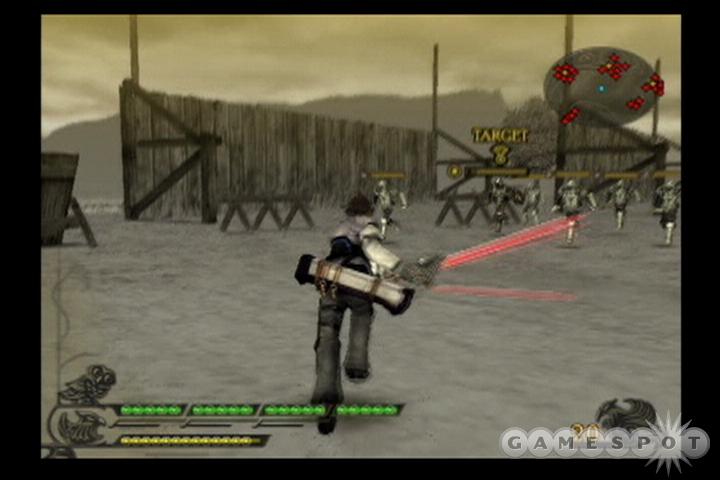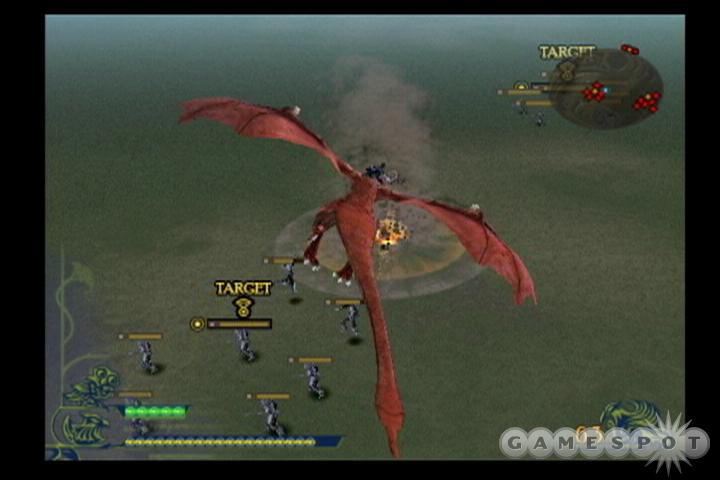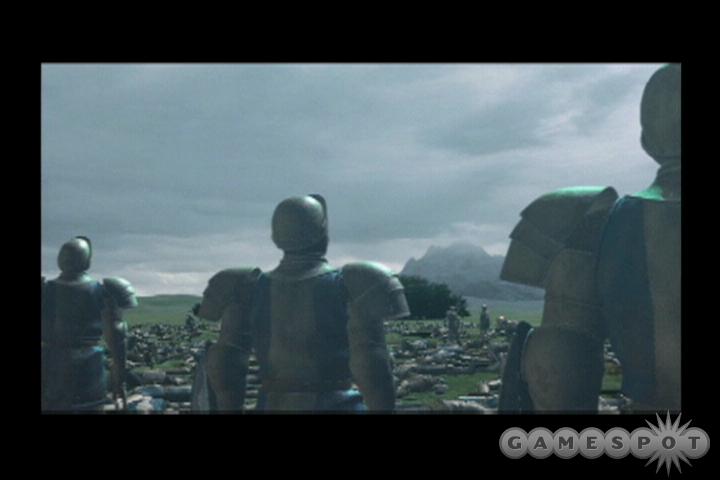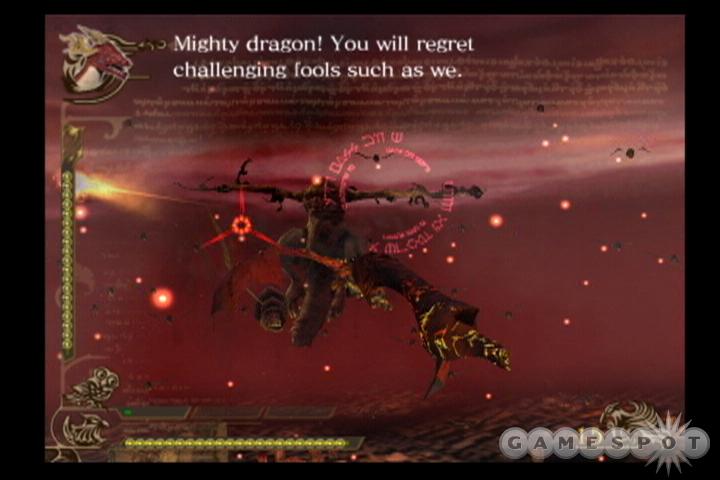In Drakengard, you'll switch between hacking and slashing your way through literally hundreds of enemies and taking to the skies on the wings of a fire-breathing dragon, whose attacks can incinerate legions of foes. There are some role-playing-game trappings, such as how you gain experience points for your kills and how you acquire an increasingly large arsenal of weapons to choose from as you proceed through the game's quest. Also, despite a conventional-sounding premise, Drakengard's story and setting are actually somewhat unusual, and the whole game has a distinctive feel to it, between the story and the strangely unsettling soundtrack. Unfortunately, the core action that dominates the gameplay is highly repetitive and not particularly interesting, but Drakengard is still worth a look from those intrigued by the game's strange theme.

The story of Drakengard focuses on Caim (which rhymes with "time"), who is an embittered young warrior who fights for the Union against the powerful threat known as the Empire. Early on in the game, Caim sustains a mortal injury while defending his homeland against the Empire's advances. As fate would have it, he happens upon a dying red dragon in the midst of all the carnage. Though Caim has no fondness for such creatures, the two realize that they are each other's only hope for survival. They perform a ritual, simply called a "pact," which restores them to health but ties their spirits to each other. Now, with this dragon's aid, Caim must defeat the Empire once and for all. Specifically, his priority throughout much of the game will be to defend his sister, who is apparently a goddess, from harm. Be that as it may, Drakengard boils down to Caim and his dragon companion blazing through droves of enemies.
This is a single-player game, the brunt of which is contained in a linear campaign spanning a series of chapters, each of which contains multiple stages, or "verses." Some stages are short, lasting just a few minutes' worth of carnage, while others are much longer and can take nearly an hour. The game isn't particularly long from start to finish (15 hours or so), but it feels rather drawn out, simply because there's little variety to it. Missions come in three varieties--or, rather, more like two and a half. Some missions take place on foot. You'll control Caim from a third-person perspective as he runs around vast, flat, wide-open environments slaying everyone in his path. You'll spend a majority of your time playing Drakengard in such sequences, which are clearly reminiscent of Koei's popular Dynasty Warriors series in how they let you easily cut your way through entire armies. The twist is that many of these missions optionally permit Caim to hop onto or off of his dragon at any time, and his dragon can not only lay waste to many types of enemies faster than Caim can, but she also moves much faster than Caim.

The other type of mission takes place high above the sky, where you'll pick off tons of targets by using your dragon's breath attacks. Here the dragon can launch seeking blasts at multiple enemies, much like in Sega's classic Panzer Dragoon series. For good measure, the game has a small handful of battles against boss opponents, all of which take place in the aerial missions. Also, the game occasionally cuts to an isometric perspective for some brief, partially interactive story sequences. There are a few good-looking prerendered cutscenes thrown in, too, as well as text screens in between each of the scenarios. There's even an overworld map that ostensibly allows you to choose from different destinations, but as mentioned, the game is linear, so the map doesn't serve an obvious purpose except to let you revisit earlier stages. In fact, while Drakengard has a hodgepodge of different elements to it, none are particularly well developed. It's almost as if the developers were forced to throw in a few superficial role-playing elements just to ensure that their game would appeal to the average fan of Square- Enix's other games. Instead, they probably should have focused on making the on-foot action more interesting.
As it stands, there just isn't a whole lot to the action. To execute Caim's melee attack combos, you just hammer on the X button. As a variation, by pressing the triangle button at certain points in the combo, you can execute a finishing blow that can flatten everyone in the area. The timing of this isn't difficult, so you'll end up reusing the same basic combos over and over and over. After every few kills, you'll stock up enough of a charge for a magic blast, which can be quite powerful depending on your weapon. You can't get too reliant on your magic, though, because red-armored enemies (which become quite common in the second half of the game) automatically counter your spells, as well as your dragon's breath. Alternatively, you'll meet a few powerful allies during your adventure whom you can temporarily transform into so that you can wreak havoc on the enemy forces. You can also block and execute evasive lateral rolls, but there's really no reason to do so--so just keep swinging.
Caim's weapons can level up several times as he uses them to kill more and more enemies, and with higher weapon levels come bigger damage, longer combos, and stronger magic. The game has dozens of different weapons in it, and you can bring and readily switch between as many as eight of them in a given mission. However, most weapons are fairly hidden and must be found in the game's optional side quests. The weapons each do have a slightly different feel to them, as well as a unique magic effect, but the action itself is so repetitive that you probably won't be too eager to find every last one of them.

The game's camera is a little awkward but works well enough when you get used to it. The way you reset the angle to the default behind-the-back perspective is to ease up on the left analog stick for a moment, whereas most games let you recenter the camera at the press of a button. What's more of an issue is that, although the game conveniently provides you with a minimap showing all enemies in the vicinity, the minimap does not orient you in any way (say, by pointing north). You'll end up frequently switching over to the full-screen map to make sure you're headed in the right direction. It's not that big of a hassle, but it's disruptive to the gameplay experience.
The plot of the game alludes to a pitched battle between the Union and the Empire, but in reality, you'll never encounter any friendly forces in battle--it's just Caim and his dragon against the world. The story does its best to convince you that the entire world hangs in the balance, and it's all terribly serious, but it's hard to take too seriously when it all boils down to you trudging around on a flat map while killing neat little clumps of enemies that are strewn about. Enemies come in a few varieties, some of which hit hard and can easily defeat you if you aren't careful. Most, though, are incredibly stupid and simply walk up to you--mounting the most halfhearted offense and defense you can imagine--while you cut a bloody swath through their ranks. Meanwhile, enemies in the aerial sequences are just weird, so you'll find that bats, strange gargoyles, flying totems, and other such things will prove to be more of a nuisance than anything else. While on dragonback, you can execute quick side-to-side strafing maneuvers to avoid enemy fire, and that's just about as far as the strategy goes. Some dragonback sequences automatically lock you onto a particular target, in which case it can be easy to become disoriented, thus causing you to literally confuse the dragon's tail for her head. However, you'll get the hang of it with practice.
Drakengard looks decent but, ultimately, not all that good. There's some occasional slowdown when too many special effects are going off all at once, but for the most part, the game runs very smoothly even when tons of bad guys are onscreen. The game is surprisingly bloody, and when killed, enemies all leave behind the same big splotch of gore before them; then it disappears. So you'll grow numb to this effect quickly. Caim's animation is pretty disappointing, considering he's the main character and all. He looks fine when swinging his weapons around, but he runs awkwardly--much like a man who's slightly hurrying to cross a street on a yellow light, rather than like the vengeful and incredibly powerful warrior he's supposed to be. Enemies are pretty simple and predictably recycle the same animations over and over. Most of the environments are very drab, completely flat, and offer nothing of interest to look at. The flying sequences may look a bit better, overall, thanks to the fairly good-looking animation of the dragon. Some of the game's spell effects look pretty good as well.

The music in Drakengard is one of the most distinctive things about the game. It's fully orchestral, but it's surprisingly dissonant. There are lots of very shrill-sounding strings on this soundtrack, which loops frequently, and it's rather bombastic. In fact, the soundtrack is the most nerve-racking and most intense aspect of the game. It almost sounds like it belongs in a psychological thriller or a horror movie. While it's not particularly pleasant on the ears, it ultimately does work very well with the game's epic theme and is certainly unique. Drakengard sports some good voice acting too, with a couple of standout performances. Most notably, there's Caim's dragon, who sounds like a stern matriarch rather than what you might have come to expect from your typical video game talking dragons. The rest of the game's audio is fine but isn't as memorable. Unfortunately, there's no ambient sound in the missions, which is disappointing since they're supposed to be in war zones, and the sounds of hacking and slashing are pretty subdued. Enemies don't scream when hit or when killed, and Caim himself--because of his pact--is mute.
To its credit, Drakengard is greater than the sum of its parts. The main cast of characters, while not terribly well developed, is interesting and rather unconventional. Though the story itself is awkwardly paced and is sometimes difficult to keep up with, it becomes one of the main motivating factors for wanting to get all the way through to the end of the game. Beyond this, multiple endings, optional missions, and all those hidden weapons might keep you busy for a while longer. The action itself in Drakengard really isn't bad; it's just very repetitive and rather simplistic. This is a shame, because if the gameplay had more to offer it would be a lot easier to recommend the game as a whole.